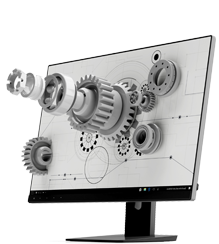What are the differences between industrial screens and commercial screens?

The most obvious difference between industrial screens and commercial screens lies in their tolerance to complex environments The design concept of industrial screens is centered around "zero failure ",
What are the differences between industrial screens and commercial screens?
Industrial screens and commercial screens: seemingly similar, but actually vastly different core differences.
In the digital age, screens, as the core carrier of human-computer interaction, have penetrated into various fields such as industrial manufacturing, commercial services, and consumer electronics. However, many users are prone to falling into the trap of thinking that using "commercial display screens" directly in industrial settings can also meet their needs. In fact, there are significant differences between industrial screens and commercial screens in terms of underlying design logic, performance standards, and application scenarios. This article will analyze the core differences between the two from four dimensions: technology, environmental adaptability, lifespan, and cost.
1、 Environmental adaptability: survival ability under extreme conditions
The most obvious difference between industrial screens and commercial screens lies in their tolerance to complex enviro、nments.
Industrial screens need to cope with extreme scenarios such as high temperature (-30 ℃ to 80 ℃), high humidity, dust, oil pollution, electromagnetic interference, or continuous vibration. Its design needs to pass IP65/IP67 protection certification, impact resistance testing (such as MIL-STD-810G), and wide temperature LCD module to ensure stable operation in scenarios such as steel smelting, mining machinery, outdoor substations, etc.
Commercial screens are designed for controlled environments such as office and retail, with a temperature range typically between 0 ° C and 50 ° C, and no strict dust and waterproof requirements. For example, if the advertising screen in a shopping mall is left in a high dust workshop for a long time, it may cause blurry display or even circuit failure.
A certain automobile manufacturing plant once used commercial screens in the welding workshop, which caused touch failure of the screens in just 3 months under metal dust and high temperature. After replacing them with industrial screens, the lifespan was extended to more than 5 years.
2、 Hardware architecture: reliability first vs cost first
The design concept of industrial screens is centered around "zero failure", while commercial screens pursue cost-effectiveness and aesthetic experience.
The industrial screen adopts military grade components such as metal shell, fully bonded explosion-proof glass, industrial grade capacitive touch chip, and is equipped with redundant power supply, dual system backup and other fault-tolerant mechanisms. The motherboard circuit needs to pass EMC anti-interference testing to avoid screen flickering caused by motor start stop or frequency converter interference.
Commercial screens often use plastic bodies and consumer grade chips, with simplified structures to reduce costs. For example, the ordering screen of a fast food restaurant frequently experiences lagging due to electromagnetic shielding on the motherboard caused by interference from kitchen equipment.
Technical details: Industrial screens often use LED backlight modules with a lifespan of over 50000 hours, while commercial screen CCFL backlight has a lifespan of only 15000 to 20000 hours.
3、 Service life and maintenance cost: a competition of implicit value
The initial purchase cost of industrial screens is relatively high (about 2-3 times that of commercial screens), but they support continuous operation for 7 × 24 hours, with an average time between failures (MTBF) of over 100000 hours, and modular design facilitates local replacement (such as repairing only the touch layer rather than the entire screen).
Although commercial screens have a low unit price, their failure rate may skyrocket in industrial scenarios, and frequent shutdowns can cause production line losses far exceeding the value of the screen itself. A certain logistics and warehousing enterprise once experienced a 2-hour delay in the sorting system due to a commercial screen malfunction, resulting in a direct loss of over one million yuan.
Data comparison: The total cost of ownership (TCO) of industrial screens over a 5-year cycle is usually 40% to 60% lower than that of commercial screens.
4、 Functional customization: dedicated interfaces and system compatibility
Industrial screens need to be deeply embedded in automation systems, therefore they have high customization capabilities:
• Supports industrial protocol interfaces such as PROFINET and EtherCAT;
• Compatible with real-time operating systems such as Linux and VxWorks;
• Can integrate PLC control, barcode scanning, and multi device linkage functions.
However, commercial screens are often equipped with HDMI/USB universal interfaces, and the system is mainly based on Android/Windows, with limited scalability.
Selection suggestion: How to accurately match requirements?
1. Industrial screens are a must-have for industrial scenarios: When it comes to production control, outdoor applications, and harsh environments, reliability far exceeds cost considerations.
2. Applicable scenarios for commercial screens: short-term interaction (such as shopping mall navigation), indoor environments with stable temperature and humidity, and non critical business processes.
3. Mixed scenario compromise solution: For example, for medical equipment operation screens, "semi industrial grade" products can be selected to achieve a balance between cost and performance.
Summary: The essential difference between industrial screens and commercial screens stems from different definitions of "risk tolerance". In the era of Industry 4.0, screens have been upgraded from "display terminals" to "production data hubs", and their stability directly affects the operational efficiency of core assets of enterprises. Understanding the difference between the two is not only a matter of technology selection, but also a rational assessment of operational risks for enterprises.
AUO Industrial LCD Panels:https://www.idtdisplay.com/products/AUO_LCD_Displays/










